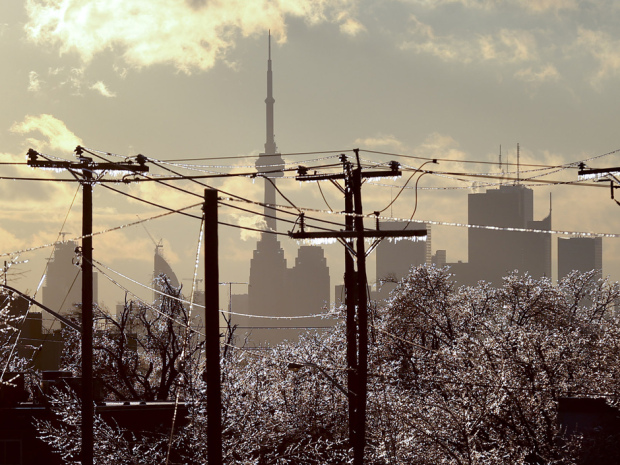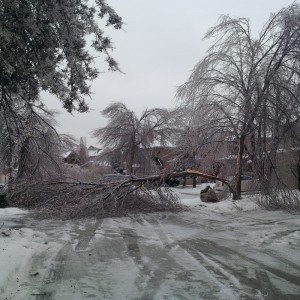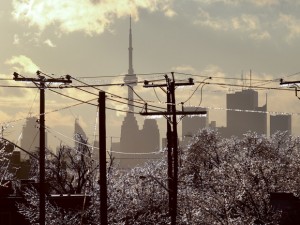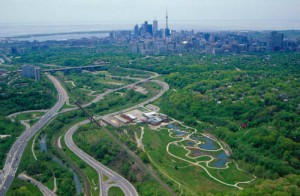December 25, 2013 – We made it back to our home this morning on Christmas Day! All the refrigerator and freezer contents have been tossed. A three day stay in a hotel has amounted to a bill of close to a thousand dollars. That plus the food puts us at around $1,200. Compared to others we have “done good.”
Our hotel, the Holiday Inn – Toronto Centre, were the most gracious hosts to an encampment of families, retirement home residents, and an assortment of pets – dogs, cats and even birds. I cannot say enough positive things about the staff and the service they provided. So many of them had no power at home and yet they never lost a step helping out hotel guests even though they had no place to go to find warmth at the end of their shift.
People were parked in the lobby with assorted bags containing household items they grabbed before seeking shelter from the cold that descended on Toronto after the ice storm with temperatures dropping to the minus mid-teens Celsius (near zero Fahrenheit) and windchills that made it considerably colder. With 30-40 millimeters (over an inch) of ice on trees and some wind the millions of trees that are a feature of Toronto were the chief natural victims, losing limbs if not trunks in the icy onslaught. And now it is snowing here on Christmas Day while I watch a very large limb across the street from me bend a power line closer and closer to the ground. They have marked it off with tape in the last few minutes but no one has come as of yet to cut it down before it takes down the power to another set of homes.
It will be days before all the power is restored. As of this writing over 70,000 “customers” in Toronto (a customer equals 2.5 people based on Toronto Hydro’s definition) have no power and it may be New Years Day before they get it back. Another cold front will move in by the weekend. I cannot imagine what it will be like for these people if they have not found a warming shelter as a safe haven.
Which brings me to the topic of today’s blog. What should a city like Toronto learn from weather events like this one? Here are some suggestions:
- Toronto has very few neighborhoods with buried power lines and yet it is one of the most heavily forested cities in North America. Our power lines are strung from light pole to light pole. This is not a good mix. When the trees are impacted by an ice storm the power is in peril. So the logical thing is build a subterranean power grid. Considering the final cost of the cleanup and the increasing frequency of catastrophic weather, hardening the power infrastructure should be a priority going forward. The rollout should occur in those areas of the city with the heaviest forest growth.
- Part of that hardening should involve changing the way power is produced. Today Toronto gets much of its power from megascale facilities including nuclear, gas-fired and hydro. These facilities send the power overland for hundreds of kilometers using high tension lines suspended from towers. You can imagine just how susceptible such an approach to power distribution can be. And weather events over the last few decades have proven to what extent how perilous climate has become to the power grid. The answer is moving to smaller power stations located closer to customers. Residential solar power could play a significant role in building this new model. Small scale meltdown-free next generation nuclear could improve reliability of the system to keep the lights on with fewer breakdowns because of catastrophic weather.
- Some are suggesting we need to cut down the trees that have proven to be the Achilles Heel for the above ground transmission lines. But Toronto’s tree canopy serves to mitigate the heat island effect that characterizes all large urban centers and distinguishes the city from so many others. When flying over Toronto you immediately are aware of just how significant the forest canopy is (see the picture below). A better solution other than implementing suggestion number 1 would be to ensure that trees and power lines minimally intersect. That means active forestry within the city to keep trees trimmed and away from power lines. The city does this but the resources dedicated to it are insufficient to meet the entire requirement.
I would welcome you, my readers, to suggest other ways cities in the 21st century can withstand the onset of weather events like the ones that seem to be increasing in frequency. So fire away with comments here, on the Facebook 21stcen site, or on The Futurist blog site.














